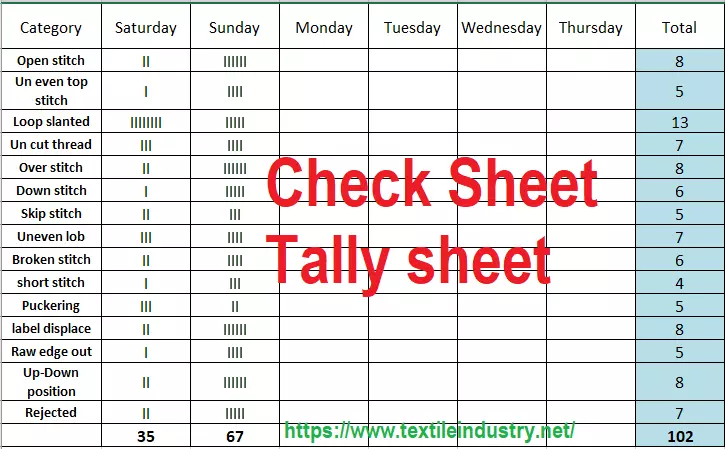Check Sheet
Quality tools are very important for quality control. There are many tools available, and 7 QC tools are very vital. A check sheet is a paper tool, used for data collection, it is a useful data-determined hearing that can be counted using tarry marks on the check sheet used as a QC to search it helps in data collection for defects and defectives or counting anything else it confirms the physical presence of defects and defective data collected by means of check sheet can be used for histogram, it is a documented proof of data collection and it can be used for future references for any analysis. In the check sheet, count the defect in a given sample using tally marks count tally marks, and write the final count in the same way as counting the other defects available in the sample using tally marks.
Check Sheet in Garments Industry
A check Sheet also called a tally sheet, an online quality control system, is very much effective for real-time data record in the cutting, sewing, and finishing line of the Garments industry. A check sheet is used for real-time data collection and analysis when QC works in one place and inspects some specific items repeatedly. This is one of the tools of 7 QC tools and the easiest and simplest tool ever. This system is very much effective for any manufacturing industry, especially in the Garments industry. You can call a defect concentration diagram. A check sheet is one kind of good structured, well-prepared form for collecting and analyzing real-time data.
When to use a check sheet/ tally sheet
- When data can be observed and collected repeatedly of the same process in sewing, cutting, or assembly section by the same person or at the same location or section.
- When collecting data on the frequency or patterns of events, problems, defects, defect location, defect causes, or similar issues.
- When collecting data from a production (Manufacturing) process
- For online quality control and analysis

Use of Check sheet in the Garments industry
Here we are giving examples of how to use the check sheet in the garments industry. The figure below shows a check sheet used to collect data on sewing line defects. For defect control, you can use such format data collected and recorded for analysis. See the data highest number of defects is broken stitch 13 PCs, the 2nd highest is skip stitch 12 pcs, then join the wrong number 8 pcs and finally broken stitch 13 pcs. Total defect 98 pcs in two days of a week. So, now try to find out the reason why such kinds of defects in sewing floors arise. Not only do you think for defect rectification how much time need and how much cost is used for rework? In sewing floor defects, not more than (DHU) arise 5%. So, this is why you can control any kind of defect in any kind of organization. Here is the example below, hope making us very clear it:
| Category | Saturday | Sunday | Monday | Total |
| Skip stitch | ןןןןןן | IIIIII | 12 | |
| Uncut thread | IIII | IIII | 8 | |
| Broken stitch | IIIIIIII | IIIII | 13 | |
| Sewing open | III | IIII | 7 | |
| Over-stitch | II | IIIIII | 8 | |
| Down stitch | I | IIIII | 6 | |
| Uneven lob | III | IIII | 7 | |
| short stitch | I | III | 4 | |
| Puckering | III | II | 5 | |
| label displace | II | IIIIII | 8 | |
| Raw edge out | I | IIII | 5 | |
| Up-Down position | II | IIIIII | 8 | |
| Rejected product | II | IIIII | 7 |
